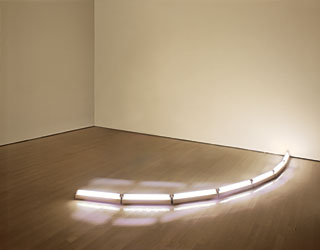|
| |
 |
|


|

untitled, 1964. Fluorescent light fixtures with cool white deluxe lamps, edition 1/3, overall: 4 x 133 1/2 x 84 3/4 inches. Solomon R. Guggenheim Museum, New York, Panza Collection. 91.3700
|

Employing only commercial fluorescent lights in his work, Dan Flavin devised a radical new art form that circumvented the limits imposed by frames, pedestals, or other conventional means of display. His embrace of the unadorned fluorescent fixture as an aesthetic object placed him at the forefront of a generation of artists whose use of industrial materials, emphasis on elementary forms, and nonhierarchical relationships among component parts became the salient characteristics of Minimalism.
The additive composition of the nominal three (to William of Ockham), dedicated to the fourteenth-century English philosopher, exemplifies Flavin's use of the fluorescent tube as a basic building block. The artist's installations became increasingly complex while remaining bound to the limited palette and standard lengths in which the fixtures were commercially produced. His subsequent development of a vocabulary of "corners," "barriers," and "corridors" engaged the environments his work occupied and revealed his interest in reconceptualizing sculpture in relation to space.
The artist Mel Bochner credited Flavin's practice as embodying "an acute awareness of the phenomenology of rooms." This awareness stemmed from Flavin's rejection of studio production in favor of site-specific "situations" or "proposals" (as the artist preferred to classify his work).
|
|